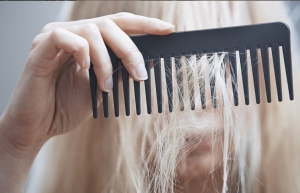Hair loss in women is often closely related not only to stress, but also to hormonal imbalances. This state of affairs often affects menopausal women over 60, as well as young girls who suffer from polycystic ovary syndrome, insulin resistance or metabolic syndrome.
Hair loss can also contribute to other reasons, for example, the use of inappropriate cosmetics, unfavorable environmental conditions. Under such conditions, the hair becomes more brittle and thin, the skin on the head is irritated and areas of thinning of the hairline appear, especially at the temples. Hair loss caused by hormonal imbalance can be either temporary or permanent.
Women's alopecia : what is it?
Alopecia is a localized or diffuse hair loss that affects both men and women. In the most common form, the problem is associated with the influence of androgenic hormones.
Women with hyperandrogenism (an excess of androgens) are markedly more prone to alopecia , even though the two conditions are not necessarily related. Women suffering from acne , seborrhea, hypertrichosis, hirsutism are more likely to suffer from female alopecia .
In women, most cases of hyperandrogenism are associated with polycystic ovary syndrome (PCOS), which is clinically manifested by anovulatory cycles, male-pattern hair growth, and sometimes obesity. The latter condition is often correlated either as a consequence or trigger of hyperandrogenism.
A separate word deserves the impact on the problem of aggressive hair care. Creams, dyes, heat from a hair dryer, conditioners, varnishes can seriously damage the scalp and hair. If your hair is always pulled back into ponytails or braids, this also contributes to loosening and falling out.
An unbalanced diet, radical diets for weight loss, causing a deficiency of vitamins and essential minerals, cause significant harm to hair health. Smoking and alcohol dehydrate the scalp and hair.
Why does hair fall out during menopause?
Women's alopecia may first manifest itself in more or less pronounced or progressive thinning of the hair after menopause, a period when there is a general decrease in estrogen levels with a change in the percentage ratio between ovarian and adrenal steroids.
The main test for the diagnosis of female alopecia is a trichogram , which can be taken in parallel with the consultation of a dermatologist-trichologist at the Bogolyuby Medical Center . With its help, the doctor will be able to fully assess the clinical picture. Be sure to study the family history of alopecia , attention is drawn to the use of contraceptives, cortisone, anabolic steroids, regularity of the menstrual cycle and existing signs of hyperandrogenism , such as diffuse hair growth in typically male areas (chin, face, chest), overweight, acne.
To confirm or exclude the diagnosis, it is also necessary to analyze the concentration in the blood of androgens, cortisol, thyroid hormones, TSH, SHBG, estrogens, progesterone and gonadotropins (LH, FSH) in different phases of the menstrual cycle.
How can I help you?
Since the causes of hair loss are a combination of many factors, a therapy that takes everything into account is appropriate. First of all, you should pay attention to your eating habits. After consulting with your doctor, you can make adjustments to your diet. In certain cases, drug therapy is prescribed, for example, hormone replacement therapy.

















